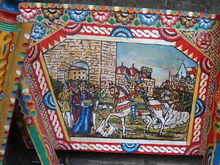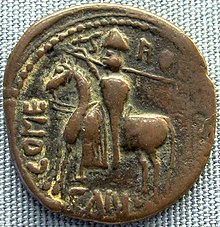Roger I (Sicily)
Roger I (* 1031 ; † June 22, 1101 in Mileto , Calabria ) was ruler of Sicily and the youngest son of Tankred of Hauteville .

Life
Gaufredus Malaterra , who compares Robert Guiskard and his brother Roger with “Joseph and Benjamin”, says of Roger: “He was a young man of the greatest beauty, tall stature, graceful figure, extremely eloquent and calm in counseling. He was farsighted in all his actions, kind and cheerful with all his men, strong and brave, and fierce in battle. ”He shared the conquest of Calabria with Robert Guiskard , and in a treaty of 1062 the brothers established a kind of“ condominium “By awarding everyone half of every castle and town in Calabria.

Robert turned Roger's attention and thirst for action to Sicily, which in addition to the Muslims inhabited many Greek Christians who were subordinate to the Arab princes, who in turn were dependent on the Sultan of Tunis . In May 1061, the brothers attacked Reggio Calabria from Messina and conquered the city. After Palermo fell in January 1072, Robert Guiskard made his brother Count of Sicily as sovereign, but kept Palermo, half of Messina and the north-eastern part, the Val Demone , to himself. It was not until 1085 that Roger was able to take up the systematic struggle against the Muslim rulers. The residence and main base on the island was Troina , in which the first Latin diocese in Sicily was established at the same time as the appointment of a bishop in Mileto .
Syracuse surrendered in March 1086, Malta in 1090, and when Noto surrendered in February 1091 the conquest was complete. Much of Robert Guiskard's success was owed to Roger's support, conversely the latter supported Duke Roger Borsa , his nephew, against Bohemond of Taranto , Capua and his rebels, whereby the actual leadership in the Hauteville family passed to the Sicilian count. In return for his help against Bohemond and his rebels, the duke gave his uncle his share in the castles of Calabria in 1085 and his share in Palermo in 1091. Roger's rule in Sicily was more real than the Roberts Guiskards in Italy. The distribution of fiefs 1072 and 1092 did not create large undivided estates, and consequently the Norman , French and Italian vassals who owed their possessions to the count did not tarnish Roger's rule with important feudal revolts.
Church politics
Politically the supreme, he also became the lord of the island church. He gave the Greek Church full freedom, created new Latin bishoprics in Syracuse and Agrigento , among others, and appointed the bishops himself. After the death of Archbishop Nicodemus, whom the Normans found during the conquest, the Archbishopric of Palermo was rededicated in the meantime as a mosque Cathedral had enthroned, occupied by a Latin. The Pope , who preferred a prince who had taken Sicily from the Muslims, granted him and his heirs the post of apostolic legate on the island in 1098 .
Tolerance policy
Roger practiced a general toleration of Arabs and Greeks and allowed each group to expand their own civilization. In the cities, the Muslims kept their mosques , their qadis and their trade privileges - in the countryside they became serfs. From the group of Muslims he recruited his infantry , to which Anselm of Canterbury said during the siege of Capua in 1098, "the brown tents of the Arabs were not countable". Nevertheless, the Latin elements soon began to predominate through the Lombards and other Italians pouring into the country during the conquest.
A trifollis minted in Mileto around 1098 shows us the count as a knight on horseback, with a Norman shield and shouldered flag lance and the inscription ROGERIUS COMES. On the back there is a seated Mother of God with a child. Roger, the "great Count of Sicily", died on June 22nd, 1101 in Mileto , Calabria , and was buried there in the church of Santa Trinità, which he founded.
Marriages and offspring
He married three times. His first wife was Judith († 1076), daughter of Count Wilhelm von Évreux and Hawisa von Echauffour. His second wife was Eremberga († 1087), daughter of Count Robert von Mortain , and his third wife was Adelheid († 1118), daughter of Margrave Manfred I of Savona .
He had a number of children with his first two wives, including:
- Matilde ⚭ Raymond IV. Count of Toulouse († 1105)
- Felizia of Sicily († around 1102) ⚭ 1097 Koloman King of Hungary († 1114)
- Konstanze ⚭ 1095 Konrad III. (1074–1101), Roman-German King , Duke of Lower Lorraine , son of Emperor Heinrich IV.
He had two sons of his third wife, Simon and Roger II , who both became his successors, as the sons from the first two marriages had died before their father.
literature
- Klaus-Peter Todt: Roger, I., Count of Sicily. In: Biographisch-Bibliographisches Kirchenlexikon (BBKL). Volume 8, Bautz, Herzberg 1994, ISBN 3-88309-053-0 , Sp. 541-543.
- Julia Becker: Count Roger I of Sicily. Pioneer of the Norman Kingdom (= library of the German Historical Institute in Rome. Vol. 117). Niemeyer, Tübingen 2008, ISBN 978-3-484-82117-0 . ( Review )
- Horst Enzensberger , Cancelleria e documentazione sotto Ruggero I di Sicilia. In: Ruggero il Gran Conte e l'inizio dello stato normanno, Roma 1977 [Centro di Studi normanno-svevi, Atti 2], pp. 15-23
- Horst Enzensberger: Fondazione o "rifondazione"? Alcune osservazioni sulla politica ecclesiastica del conte Ruggero. In: Chiesa e società in Sicilia. L 'età normanna. Atti del I Convegno internazionale organizzato dall 'arcidiocesi di Catania, 25-27 November 1992, a cura di Gaetano Zito. Torino 1995, pp. 21-49.
- Horst Enzensberger: The Latin Church and the founding of a diocese in Sicily at the beginning of the Norman rule. In: Medioevo Italiano. Rassegna storica online 1 (2000), No. 2, pp. 1-40 downloadable articles PDF.
- Julia Becker: Un dominio tra tre culture. La contea di Ruggero I alla fine dell'XI secolo. In: Sources and research from Italian archives and libraries 88 (2008) 1–33. ( online )
- Alheydis Plassmann : The Normans. Conquer - rule - integrate (= Kohlhammer-Urban pocket books. Vol. 616). Kohlhammer, Stuttgart 2008, ISBN 978-3-17-018945-4 .
Web links
- Robert Guiscard's Genealogy , accessed June 6, 2014.
- Research project on the edition of Rogers I's documents at the DHI (meanwhile completed) ( Memento from March 4, 2016 in the Internet Archive )
- Rogers coin in the Berlin Coin Cabinet
Remarks
- ↑ Trifollis ROGERIUS COMES ; Bernd Kluge: Numismatics of the Middle Ages. Volume I: Handbook and Thesaurus Nummorum Medii Aevi (Staatliche Museen zu Berlin, Münzkabinett and Austrian Academy of Sciences, phil.-hist. Class, session reports 769, publications of the Numismatic Commission 45), Berlin / Vienna 2007, No. 822 ISBN 978- 3-88609-603-9 (Germany), ISBN 978-3-7001-3932-4 (Austria)
- ↑ This term is not contemporary. All alleged documents by Rogers I with this title are forgeries, cf. Enzensberger, Cancelleria
| predecessor | Office | successor |
|---|---|---|
| - |
Count of Sicily 1061–1101 |
Simon |
| personal data | |
|---|---|
| SURNAME | Roger I. |
| BRIEF DESCRIPTION | Ruler of Sicily and the youngest son of Tankred von Hauteville |
| DATE OF BIRTH | 1031 |
| DATE OF DEATH | June 22, 1101 |
| Place of death | Mileto , Calabria |

